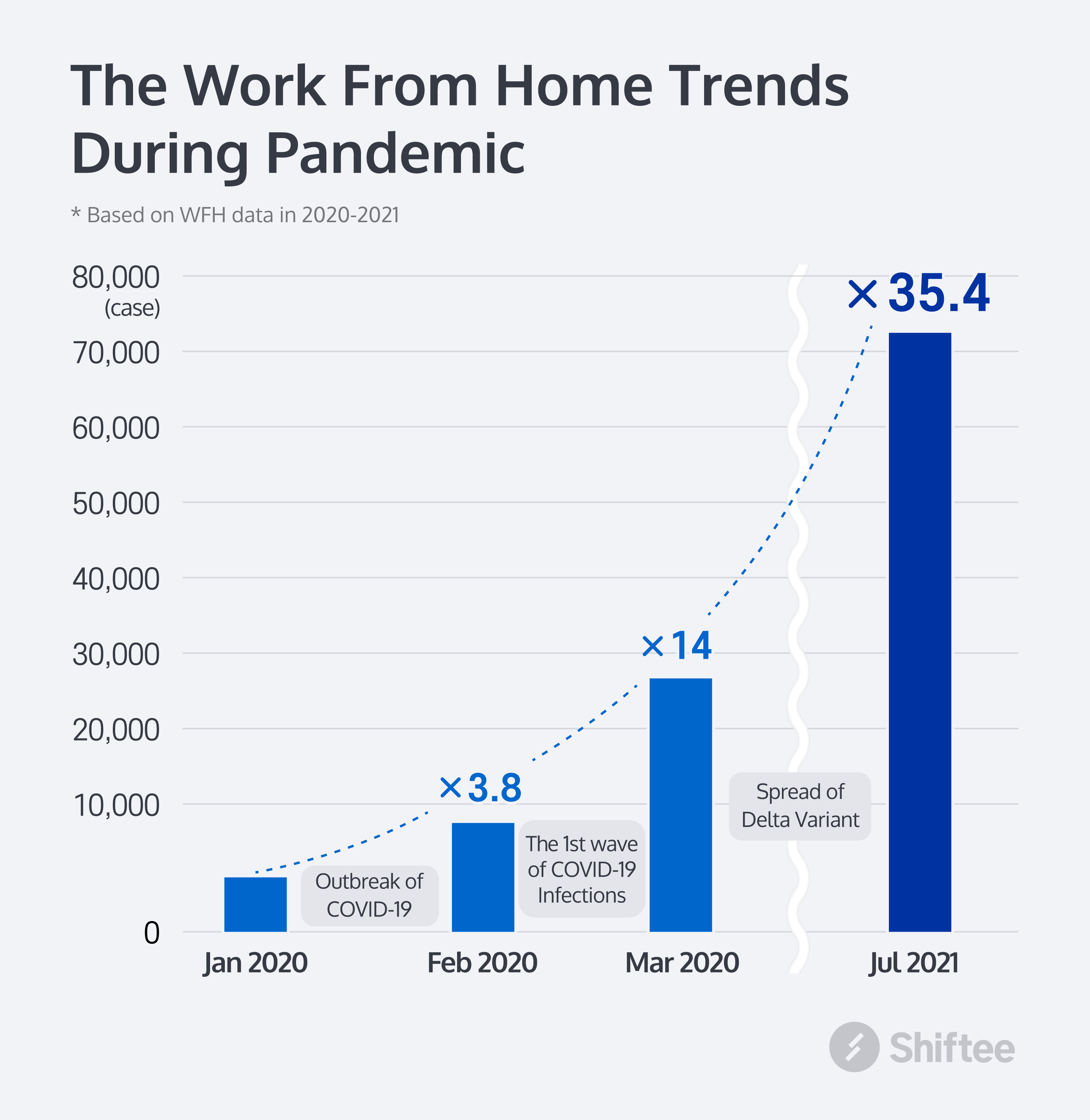Shiftee Reveals WFH Big Data Analysis of 2020 and 2021
2022-12-14

"Shiftee reveals WFH big data analytics results over the past two years during the pandemic"
"The total WFH ratio increased in proportion to the spread of Covid-19 virus in Korea"
WFH Statistics of Companies in 2020 and 2021
Shiftee, South Korea's largest workforce management software, announced that work from home ratio skyrocketed after the outbreak of Covid-19. The result was based on the data of shift pattern changes over the past two years(2020 and 2021) in workplaces using Shiftee.
The data analysis was based on the WFH·Remote Work conversion ratio of workplaces using Shiftee. According to the results, conversion from traditional office work to untact-working environment has increased dramatically after the outbreak of Covid-19. The data showed that monthly average ratio of WFH shift has increased by 7 times over the past two years when compared to January, 2020. This analysis was based on the work from home data recorded in 2020 and 2021.
Increasing and Decreasing Trends in Accordance with Social Distancing Measures and Wave of Infections
The monthly average ratio of WFH shift has increased by 7 times in the last two years and showed clear increasing and decreasing trends in accordance with the spread of Covid-19.
Before the first big wave of infections began in February and March 2020, the number of WFH cases increased 3.8 times in a month from 1,960 in January 2020 to 7,370 in February.
In March 2020, as more and more companies implemented emergency WFH plans, the number of WFH shift requests have increased sharply to 27,298 and jumped about 14 times in comparison to January 2020. Since then, as the spread of the virus has subsided, the WFH conversion rate has decreased slightly, maintaining about 10,000 cases. But as the spread of the virus has worsened at the end of November 2020, recording the highest confirmed cases than ever at that time, WFH conversion has risen again to about 40,000 cases in December.
This trend remained steady as the year changed to 2021. However, with the spread of the Delta variant, social distancing measures have been strengthened, resulting in WFH shifts reaching nearly 70,000 cases from July to August. This is the highest conversion rate in the past two years which is 35.4 times higher than what it was in January 2020, just before the outbreak of Covid-19.
Expectation to a New Era of Work : Hybrid Work (Balancing Between Office Work and WFH)
According to a survey conducted by the Korea Employers Federation in last year, out of 69 workplaces of the top 100 companies in revenue in South Korea, 88.4% replied that they were working from home, which implies that large enterprises also had a high conversion rate to the untact working environment.
In the case of startups, there have been very few workplaces that implemented WFH plans before Covid-19. But since the outbreak of Covid-19, the number of places that implemented WFH plans or flexible working hours has been increasing rapidly. According to an analysis conducted by Shiftee, Covid-19 has dramatically changed how we view WFH, which seems to become a much more widely accepted practice across the country with the number of workplaces implementing WFH maintaining about 50,0000 cases in the last fourth quarter.
Seung Won Shin, CEO of Shiftee, mentioned “It seems that companies have already learned that working hours can be managed well even when working from home without worrying about work efficiency. As for WFH, which started at the risk of Covid-19, the data showed that most employees are satisfied and there is no significant difference in terms of work-efficiency compared to traditional office work. So I am optimistic that hybrid work, properly combining office work and WFH, will be implemented as the next model of work even after the pandemic.”
From WFH to Hybrid Work, Get Started with Shiftee
When citing the content, be sure to indicate the source according to copyright law.






